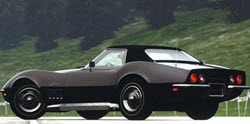1978 Corvette Sting Ray

1978 was in many ways an important year for the Corvette Sting Ray. The first Corvette was produced back in 1953, and the 1978 Corvette Sting Ray would therefore mark the 25 year celebration of this legendary car. The design changed dramatically and the new “fastback” style was introduced for the first time. A Corvette also paced the Indy 500 race and this was celebrated with a special edition 1978 Corvette Sting Ray. It was painted in light silver and black and decorated with a distinct red stripe. The 1978 Corvette Sting Ray was also special in another way – it was the first Corvette Sting Ray released after the resignation of head designer Bill Mitchell in 1977. Bill Mitchell was the last one of the “old team” behind the Corvette Sting Ray. GM president Ed Cole had retired in 1974 and chief engineer Zora Arkus-Duntov had followed him in 1975.
As mentioned above, the year of 1978 was they year when Corvette celebrated its 25th birthday and this could of course not go unnoticed in the cars. All 1978 Corvette Sting Ray cars were decorated with a special commemorative badge on the front nose. The text on the round emblem read “CORVETTE 25 – 1953 ANNIVERSARY 1978”. A special colour scheme was also offered. It used two different shades of silver: dark silver for the lower body and light silver for the upper body. The two shades were separated by a dark silvery stripe along the car. Some people believed that this would turn into a high priced collectible, but the celebrative colour scheme was not limited and over 15,000 two-toned 1978 Corvette Sting Ray cars were sold.
The new “fastback” design of the 1978 Corvette Sting Ray gave the car a smoother silhouette and made the available luggage space larger. Reaching the luggage space was however complicated. Just as in the old mid-year coupes, you had to access the area through the seats. A hatchback solution would not be used until four years later, in the 1982 Corvette.
The interior of the 1978 Corvette Sting Ray was very different from the previous model. The map pockets in front of the passenger seat had been replaced by a glove box and the traditionally rounded gauges were placed in a squared off area. A problem with the 1978 Corvette Sting Ray was that the interior rapidly became unbearably hot during warm and sunny days. Nearly 90 percent of the buyers paid an additional $635 to have a 1978 Corvette Sting Ray with air conditioning.
When a Corvette paced the Indy 500 race, a special edition 1978 Corvette Sting Ray was released to celebrate this. As mentioned above, the special edition car was painted in light silver, black and red. There seats were also different from the standard 1978 Corvette Sting Ray. The original plan was to create no more than 300 special edition cars to make them rare and attractive. It was also a way of celebrating Corvette’s 25th birthday, since the 1953 Corvette was produced in no more than 300 units. The overwhelming demand did however cause Chevrolet to change their minds, and no less than 6,502 Indianapolis 500 pace car replicas were produced. This meant that each Corvette dealer would get one car, and also left room for a few extra cars that could be used for promotional purposes.



